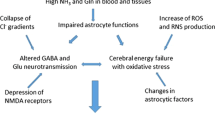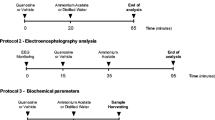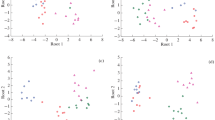Abstract
The neuromodulators, adenosine, serotonin, and glycine, did not alter the course of hepatic encephalopathy (HE) that followed a portacaval shunt and hepatic artery ligation in rats. The substances were instilled into the brain ventricle through an intraventricular cannula in doses that affect other aspects of behavior in the normal rat (adenosine, suppression of food intake; serotonin, loss of muscle strength and ataxia; glycine, leaning and circling). A subconvulsive dose of the glycine antagonist, strychnine, also had no effect on the course of HE. A large dose of the adenosine antagonist, caffeine, had a depressive rather than excitatory effect and shortened the time taken to induction of coma. These studies and a similar previous one with γ-aminobutyric acid (GABA) suggest that the inhibitory neuromodulators do not have a prominent role in the pathogenesis of hepatic coma.
Similar content being viewed by others
References
Borg, J., Warter, J. M., Schlienger, J. L., Imler, M., Marescaux, C., and Mack, G. (1982). Neurotransmitter modifications in human cerebrospinal fluid and serum during hepatic encephalopathy.J. Neurol. Sci. 57: 343–356.
Bugge, M., Bengtsson, F., Nobin, A., Jeppsson, B., and Herlin, P. (1986). Metabolism of monoamine in the brain after total hepatectomy in the rat.Exp. Neurol. 94: 11–20.
Bugge, M., Bengtsson, F., Nobin, A., Jeppsson, B., and Herlin, P. (1987). The effect of liver ischemia on brain monoamine synthesis in the rat.Res. Exp. Med. 187: 119–130.
Cummings, M. G., James, J. H., Soeters, P. B., Keane, J. M., Foster, J., and Fischer, J. E. (1976). Regional brain study of indoleamine metabolism in the rat in acute hepatic failure.J. Neurochem. 27: 741–746.
Curzon, G., and Knott, P. J. (1977). Environmental, toxicological, and related aspects of tryptophan metabolism with particular reference to the central nervous system.CRC Crt. Rev. Toxicol. Sept: 145–187.
Feldberg, W., and Sherwood, S. L. (1954). Injection of drugs into the lateral ventricle of the cat.J. Physiol. 123: 148–167.
Ferenci, P., Pappas, S. C., Munson, P. J., Henson, K. and Jones, E. A. (1984). Changes in the status of neurotransmitter receptors in a rabbit model of hepatic encephalopathy.Hepatology 4: 186–191.
Fischer, J. E., James, J. H., and Baldessarini, R. (1972). Changes in brain amines following portal flow diversion and acute hepatic coma: Effects of levodopa (L-Dopa) and intestinal sterilization.Surg. Forum 23: 348–350.
Giges, B., Dein, H. L., Sborov, V. M., Seligson, D., and Howard, J. M. (1953). Experimental hepatic coma.Surg. Gynec. Obstet. 97: 763–768.
Knell, A. J., Davidson, A. R., Williams, R., Kantamaneni, B. D., and Curzon, G. (1974). Dopamine and serotonin metabolism in hepatic encephalopathy.Brit. Med. J. 1: 549–551.
Levine, A. S., and Morley, J. E. (1983). Effect of intraventricular adenosine on food intake in rats.Pharmacol. Biochem. Behav. 19: 23–26.
Mattson, W. J., Jr., and Turcotte, J. G. (1969). Survival and metabolism in experimental endogenous hepatic coma.Surg. Gynec. Obstet. 128: 557–564.
Patel, J., Marangos, P. J., and Boulenger, J. P. (1984). Adenosine: Its action and sites of action in the CNS. InBrain Receptor Methodologies. Part B, Academic Press, New York, pp. 297–325.
Pycock, C. J., and Kerwin, R. W. (1981). The status of glycine as a supraspinal neurotransmitter.Life Sci. 28: 2679–2686.
Rappaport, A. M., and Lotto, W. N. (1951). Experimental hepatic coma.Proc. Soc. Exp. Biol. Med. 78: 14–15.
Rzepczynski, D., Zieve, L., Lindblad, S., and LaFontaine, D. (1986).In vivo studies of GABAergic effects in experimental hepatic encephalopathy.Hepatology 6: 902–905.
Young, A. B., and Snyder, S. H. (1973). Strychnine binding associated with glycine receptors in the central nervous system.Proc. Natl. Acad. Sci. 70: 2832–2836.
Zieve, L., Ferenci, P., Rzepczynski, D., Ebner, J., and Zimmerman, Ch. (1987). A benzodiazepine antagonist does not alter the course of hepatic encephalopathy or neural γ-aminobutyric acid (GABA) binding.Metab. Brain Dis. 2: 201–205.
Author information
Authors and Affiliations
Rights and permissions
About this article
Cite this article
Rzepczynski, D., Zieve, L. & Lindblad, S. Inhibitory neuromodulators do not alter the course of experimental hepatic encephalopathy. Metab Brain Dis 3, 211–216 (1988). https://doi.org/10.1007/BF00999237
Received:
Accepted:
Issue Date:
DOI: https://doi.org/10.1007/BF00999237




